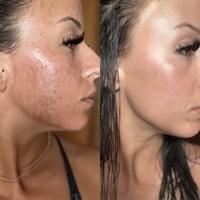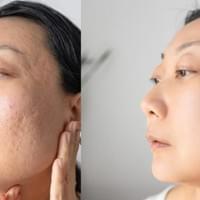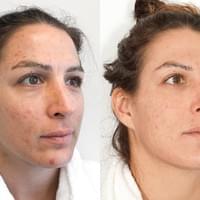
- More Services
- …
- More Services
- More Services
- …
- More Services
Your Complete Guide to CO2 Laser Resurfacing
CO2 (carbon dioxide) laser resurfacing uses targeted beams of light to remove the superficial layer of your skin. This stimulates newer skin to grow in its place.
CO2 laser resurfacing uses pulses of laser light to remove the top layer of cells from your skin. The laser penetrates the skin’s surface, and the water in your skin cells absorbs the light.
When this happens, the epidermis, or superficial layer of your skin, is vaporized. The dermis, or middle layer, heats up, stimulating the growth of new collagen fibers. As the area heals, new, firmer, smoother skin replaces the old layer.
Depending on what they are treating, a dermatologist or cosmetic surgeon might use a fractional laser, which targets smaller sections of the skin. Fractional lasers, however, don’t affect every cell like traditional CO2 lasers, so they are mostly used for fine lines or blotchy skin rather than larger areas of skin.
How to prepare
Your dermatologist will give you instructions to prepare for treatment. Depending on your medical history, pre-care typically involves:
- avoiding tanning or heavy sun exposure for 4 weeks before treatment
- not using medications that cause sun sensitivity, such as doxycycline, for 3 days before treatment
- taking an antiviral medication for a few days before and after treatment if you have a history of herpes or shingles
- quitting smoking for 2 weeks before and after treatment, since smoking can interfere with healing
For acne scars:
Ablative carbon dioxide laser or Er:YAG lasers can be used in skin types 1 to 4 to help treat acne scars. They should not be used in skin types 5 and 6, as thermal injury commonly causes postinflammatory hyperpigmentation.
The procedure
Here’s an idea of what to expect on the day of your CO2 laser treatment:
- This outpatient procedure generally takes between 30 minutes and 2 hours, depending on the issue being addressed and the area of skin receiving treatment.
- CO2 laser resurfacing does involve some pain. The level of pain you experience will depend on the depth and extent of resurfacing, the skill of the dermatologist or surgeon, and your own pain tolerance.
- You’ll receive a combination of local anesthetic and a sedative to prevent pain and help you relax. For extensive resurfacing, you may receive general anesthesia so you sleep through the treatment.
- Before the treatment begins, your skin will be thoroughly cleaned, and you’ll receive special eyewear to protect your eyes from the laser.
- During the treatment, the dermatologist or surgeon will move the laser wand slowly over the area of skin being treated.
- You may receive an ice pack to apply to the treated area for 15 minutes to prevent swelling.
- Finally, an antibacterial ointment and nonstick dressing will be applied to the treated skin. Leave this on as instructed, usually for 24 hours.
You may need more than one treatment session, depending on the treatment required and intensity of the laser used.
FAQs
Your Questions Answered

About Us
Dr. Joshua Hiep Le, DO
Elevated Image & Primary Care
4300 Talbot Road South, Suite 105, Renton, WA, 98055
Resources
Tutorials
Brand Assets
Contact Us
+1 206-395-4748
+1 206-801-6843
elevatedprimarycare316@gmail.com
Contact: +1 206-395-4748 | +1 206-801-6843
Fax: 206-703-2817
elevatedprimarycare316@gmail.com
Elevated Image & Primary Care
4300 Talbot Rd. S # 105 Renton, WA, 98055



